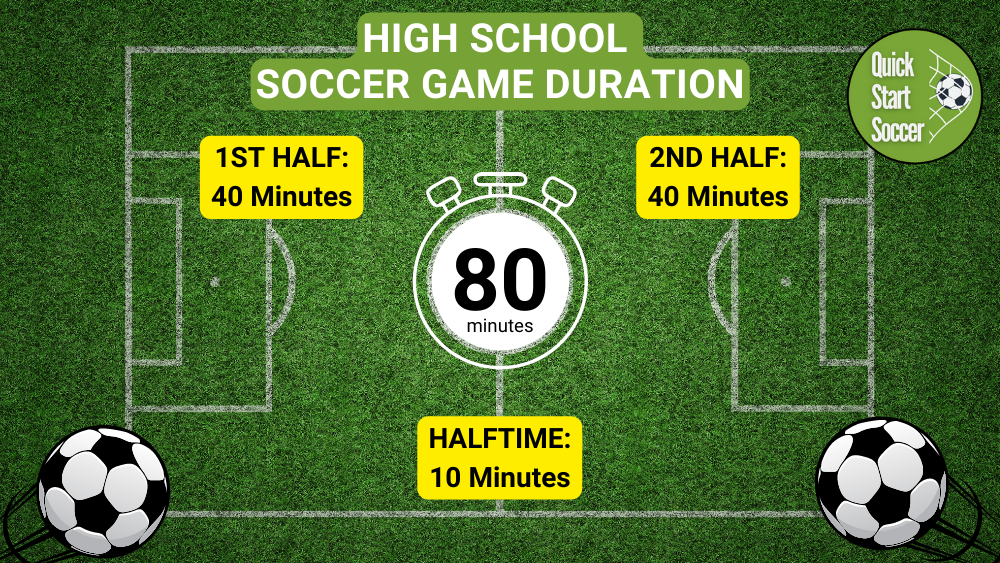How Long Is A High School Soccer Game?
Soccer, known as football in many parts of the world, is more than just a game. It’s a sport that teaches teamwork, discipline, and endurance, and its popularity in high schools across the globe is a testament to its universal appeal. One question often asked by players, parents, and fans alike revolves around the length of these games, particularly at the high school level. So, how long is a high school soccer game?
In its simplest form, the answer is that a typical high school soccer game lasts approximately 80 minutes. This duration consists of two halves of 40 minutes, with a break in the middle, known as halftime, which usually lasts for 10 minutes.
Below, we will explain how long a high school soccer game is and examine factors that can extend this time. We will also look at how the duration of high school matches compares to those at other levels of play.
About High School Soccer
A standard high school soccer game consists of two teams, each with 11 players, including a goalkeeper. The aim of the game is to score more goals than the opposing team within the given time. A typical soccer match consists of two halves, and each half is a continuous play period, meaning the clock doesn’t stop when the ball goes out of play or a foul is committed. Instead, the referee keeps track of these stoppages and adds this time to the end of each half. This is known as stoppage or injury time.
At the high school level, the halftime break usually lasts 10 minutes. This provides a rest and a strategizing period for the teams. It is also the time when teams switch ends of the field. Just like professional soccer, games can be won, lost, or tied. High school games typically do not include extra time or penalty shootouts during regular season matches. These are more commonly seen during tournament or playoff games where a winner must be decided.
Duration Of A High School Soccer Game

As mentioned earlier, a typical high school soccer game lasts 80 minutes. This time is divided into two halves of 40 minutes each, separated by a halftime break.
Duration Of Each Half
Each half of a high school soccer game lasts 40 minutes. Unlike some other sports, the clock in soccer is continuous, which means it doesn’t stop for fouls, out-of-play balls, or minor injuries. This duration is shorter than professional soccer games, which have 45-minute halves. The shorter length of high school games is primarily for the safety and endurance of younger players.
Duration Of Halftime
The halftime break in a high school soccer game typically lasts 10 minutes. This break provides players with much-needed rest, allows coaches to discuss strategies and make adjustments, and teams to switch ends of the field.
It’s important to note that the length of high school soccer games can vary slightly from region to region. Different leagues or divisions may have slightly different rules. Furthermore, two periods of extra time are usually played if a playoff or championship game ends in a tie. If the game is still tied after extra time, the game will go to a penalty shootout in order to determine a clear winner. More on that below!
Factors That Can Affect The Game Duration
In soccer, the clock doesn’t stop. This continuous nature leads to what is known as “stoppage time” or “injury time,” which can extend the duration of a game. Let’s explore these factors in detail.
Injury Time
Soccer is a physical sport, and occasional injuries are part of the game. When a player is injured, and play is stopped, the referee makes a note of the lost time. This lost time is then added to the end of each half to ensure the full 40 minutes of playing time. This added time is known as “injury time” or “stoppage time.”
Referees can also add time on for substitutions made by teams during play and excessive time wasted from one team or another. Ultimately, it’s at the referee’s discretion to decide the amount of stoppage time added, and it can vary from game to game.
Extra Time and Penalty Shootouts:
In a regular high school soccer game, a tie score at the end of regulation time is considered a tie, and teams are usually awarded 1 point each. However, a winner must be decided in certain situations, such as tournaments or playoff games. In these cases, “extra time” – two additional periods of play – may be used. A penalty shootout determines the winner if the score remains tied after extra time. This can significantly extend the duration of a highschool soccer match.
Delays
Unforeseen circumstances such as severe weather conditions, equipment issues, or other disruptions can cause delays in the game. These delays are usually beyond anyone’s control but can extend the length of a high school soccer game.
It’s essential to remember that while these factors can extend the overall duration of a game, they don’t change the actual playing time. The aim is always to ensure that 80 minutes of actual soccer is played in a high school game.
Comparison With Other Levels of Play
The duration of a soccer match can vary significantly depending on the level of play. Let’s see how high school soccer compares to other levels, specifically professional and college soccer.
Professional Soccer
In contrast to high school soccer’s 80-minute length, professional soccer matches typically last 90 minutes, divided into two halves of 45 minutes each, with a 15-minute halftime break. The longer game duration is due to professional players’ heightened endurance and skill level. Furthermore, like high school soccer, stoppage time, extra time, and penalty shootouts can extend the overall game duration.
College Soccer
College soccer games in the United States typically last 90 minutes, similar to professional matches. They are divided into two halves of 45 minutes each with a 15-minute halftime.
The differences in game length across these levels are primarily due to factors such as player safety, endurance levels, and the competitive structure of the leagues. Understanding these variations underscores the unique nature of each level of play and provides a broader context for appreciating the game of soccer.
Wrapping Up
Understanding the duration of a high school soccer game and the factors that can influence it provides a deeper appreciation of the sport. It’s more than just knowing how long a game lasts; it’s about understanding the intricacies of the game that so many of us love. So, the next time you’re preparing for a high school soccer match, whether as a player, coach, parent, or fan, remember that while the clock may read 80 minutes, the memories and experiences created can last a lifetime.


